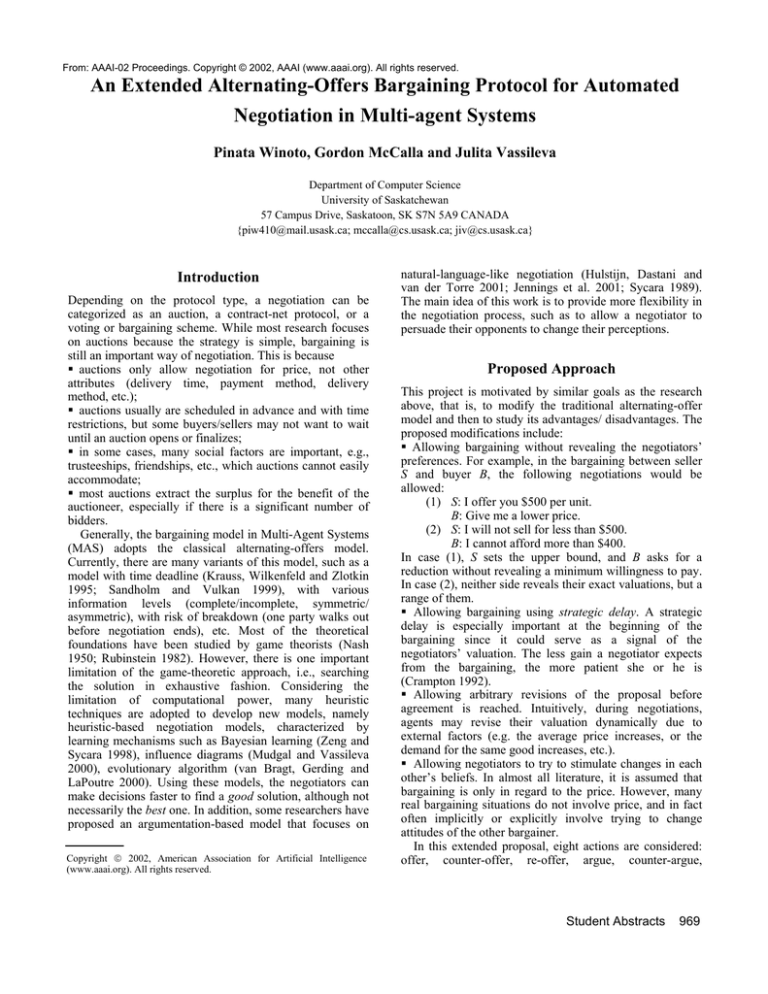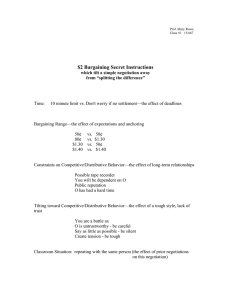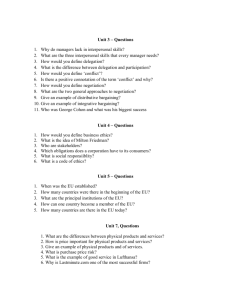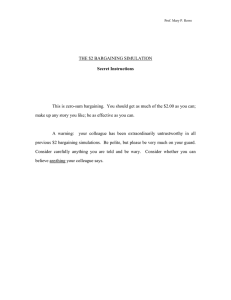
From: AAAI-02 Proceedings. Copyright © 2002, AAAI (www.aaai.org). All rights reserved.
An Extended Alternating-Offers Bargaining Protocol for Automated
Negotiation in Multi-agent Systems
Pinata Winoto, Gordon McCalla and Julita Vassileva
Department of Computer Science
University of Saskatchewan
57 Campus Drive, Saskatoon, SK S7N 5A9 CANADA
{piw410@mail.usask.ca; mccalla@cs.usask.ca; jiv@cs.usask.ca}
Introduction
Depending on the protocol type, a negotiation can be
categorized as an auction, a contract-net protocol, or a
voting or bargaining scheme. While most research focuses
on auctions because the strategy is simple, bargaining is
still an important way of negotiation. This is because
! auctions only allow negotiation for price, not other
attributes (delivery time, payment method, delivery
method, etc.);
! auctions usually are scheduled in advance and with time
restrictions, but some buyers/sellers may not want to wait
until an auction opens or finalizes;
! in some cases, many social factors are important, e.g.,
trusteeships, friendships, etc., which auctions cannot easily
accommodate;
! most auctions extract the surplus for the benefit of the
auctioneer, especially if there is a significant number of
bidders.
Generally, the bargaining model in Multi-Agent Systems
(MAS) adopts the classical alternating-offers model.
Currently, there are many variants of this model, such as a
model with time deadline (Krauss, Wilkenfeld and Zlotkin
1995; Sandholm and Vulkan 1999), with various
information levels (complete/incomplete, symmetric/
asymmetric), with risk of breakdown (one party walks out
before negotiation ends), etc. Most of the theoretical
foundations have been studied by game theorists (Nash
1950; Rubinstein 1982). However, there is one important
limitation of the game-theoretic approach, i.e., searching
the solution in exhaustive fashion. Considering the
limitation of computational power, many heuristic
techniques are adopted to develop new models, namely
heuristic-based negotiation models, characterized by
learning mechanisms such as Bayesian learning (Zeng and
Sycara 1998), influence diagrams (Mudgal and Vassileva
2000), evolutionary algorithm (van Bragt, Gerding and
LaPoutre 2000). Using these models, the negotiators can
make decisions faster to find a good solution, although not
necessarily the best one. In addition, some researchers have
proposed an argumentation-based model that focuses on
Copyright 2002, American Association for Artificial Intelligence
(www.aaai.org). All rights reserved.
natural-language-like negotiation (Hulstijn, Dastani and
van der Torre 2001; Jennings et al. 2001; Sycara 1989).
The main idea of this work is to provide more flexibility in
the negotiation process, such as to allow a negotiator to
persuade their opponents to change their perceptions.
Proposed Approach
This project is motivated by similar goals as the research
above, that is, to modify the traditional alternating-offer
model and then to study its advantages/ disadvantages. The
proposed modifications include:
! Allowing bargaining without revealing the negotiators’
preferences. For example, in the bargaining between seller
S and buyer B, the following negotiations would be
allowed:
(1) S: I offer you $500 per unit.
B: Give me a lower price.
(2) S: I will not sell for less than $500.
B: I cannot afford more than $400.
In case (1), S sets the upper bound, and B asks for a
reduction without revealing a minimum willingness to pay.
In case (2), neither side reveals their exact valuations, but a
range of them.
! Allowing bargaining using strategic delay. A strategic
delay is especially important at the beginning of the
bargaining since it could serve as a signal of the
negotiators’ valuation. The less gain a negotiator expects
from the bargaining, the more patient she or he is
(Crampton 1992).
! Allowing arbitrary revisions of the proposal before
agreement is reached. Intuitively, during negotiations,
agents may revise their valuation dynamically due to
external factors (e.g. the average price increases, or the
demand for the same good increases, etc.).
! Allowing negotiators to try to stimulate changes in each
other’s beliefs. In almost all literature, it is assumed that
bargaining is only in regard to the price. However, many
real bargaining situations do not involve price, and in fact
often implicitly or explicitly involve trying to change
attitudes of the other bargainer.
In this extended proposal, eight actions are considered:
offer, counter-offer, re-offer, argue, counter-argue,
Student Abstracts
969
strategic delay, accept and reject. And many factors
influencing an agent’s decision may be considered, such as
private valuation, discount rate, bargaining time,
unresolved disagreements, convergence rate, the likelihood
of breakdown, etc.
problems, such as what kind of learning mechanism is
appropriate? should agents trust the arguments made by
their opponent? should every agent maintain a history of
interactions and a model of other agents?
Acknowledgements
Current and Future Work
In order to evaluate the performance of the new protocols,
an agent-based simulation will be designed. The
experiments will consist of two conditions: a conventional
alternating-offer model (control) and a modified model
designed using some or all of the modifications described
earlier. There are three criteria used in the measurement of
the protocol’s efficiency: percentage of failure, length of
bargaining, and computational costs. And there are also
two metrics that are used to assess the protocol’s
effectiveness: fairness and participation rate.
The measurement of these five criteria is as follows:
! Ratio of failure = number of failures (walkouts)/ number
of bargaining sessions.
! Length of bargaining = number of alterations until
negotiation concluded.
! Computational costs = time needed for each decision.
! Fairness = % difference between buyer and seller’s
surplus, i.e. how much they had to concede relative to their
expectations.
! Participation rate = proportion of participants in
extended alternating-offer bargaining compared to
participants in classical alternating-offer bargaining.
Agents used in the experiments are assumed to be
bounded rational and learning agents. For instance, buyer
agents will maximize their utility UB based on the
following parameters: their private valuation, time
deadline, belief about market price, belief about a seller’s
time deadline, belief about the probability of a seller to
walkout, probability to find other sellers, the price
offered/counter offered by a seller, perceived probability
that a seller will accept their offer, the weight (importance)
assigned to the market price, and their belief about the
trustworthiness of a seller’s statement. Moreover, agents
choose the action that yields a higher expected return in
their view. For example, by indicating that the market price
will be very low in the near future, a buyer can persuade a
seller to sell with a lower price today, since if the buyer
walks out, the seller will get less from the market.
Up to now, two steps in the research have been carried
out:
! The characteristics of the bargaining protocols have been
analytically studied to find the answer to some basic
questions such as: will the bargaining always converge? in
what conditions do bargaining solutions exist? what
happens if two agents use different criteria to update their
beliefs? There are, of course, many other questions which
need to be studied.
! The experimental design of an agent-based simulation
has been proposed, which could serve as a test-bed of the
protocol design. However, there are still many unsolved
970
Student Abstracts
This work is funded through a research assistantship from
the Canadian Natural Sciences and Engineering Research
Council.
References
Crampton, P. C. 1992. Strategic Delay in Bargaining with
Two-Sided Uncertainty. Review of Economic Studies 59(1):
205-225.
Hulstijn, J.; Dastani, M.; and van der Torre, L. 2001.
Negotiation Protocols and Dialogue Games. In
Proceedings of the Fifth International Conference on
Autonomous Agents, 180-181, Montreal, Canada.
Jennings, N. R.; Faratin, P.; Lomuscio, A. R.; Parsons, S.;
Sierra, C.; and Wooldridge, M. 2001. Automated
Negotiation: Prospects, Methods and Challenges.
International Journal of Group Decision and Negotiation
10(2): 199-215.
Krauss, S.; Wilkenfeld, K.; and Zlotkin, G. 1995.
Multiagent Negotiation under Time Constraints. Artificial
Intelligence Journal 75(2): 297-345.
Mudgal, C., and Vassileva, J. 2000. Bilateral Negotiation
with Incomplete and Uncertain Information: A DecisionTheoretic Approach Using a Model of the Opponent. In
Klusch and Kerschberg (Eds.) Cooperative Information
Agents IV, LNAI vol. 1860, 107-118, Springer-Verlag.
Nash, J. F. 1950. The Bargaining Problem. Econometrica
18(2): 155-162.
Rubinstein, A. 1982. Perfect Equilibrium in a Bargaining
Model. Econometrica 50(1): 97-110.
Sandholm, T. W., and Vulkan, N. 1999. Bargaining with
Deadlines. In Proceedings of the Sixteenth National
Conference on Artificial Intelligence, 44-51, Orlando, FL.
Sycara, K. 1989. Argumentation: Planning other Agents’
Plans. In Proceedings of the Eleventh International Joint
Conference on Artificial Intelligence, 517-523.
van Bragt, D.D.B.; Gerding, E.H.; and La Poutre, J.A.
2000. Equilibrium Selection in Alternating-Offers
Bargaining Models: The Evolutionary Computing
Approach. CWI Technical Report available at
http://www.cwi.nl/projects/ASTA/2000Q3.html
Zeng, D., and Sycara, K. 1998. Bayesian Learning in
Negotiation. International Journal Human-Computer
Studies 48: 125-141.




